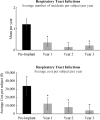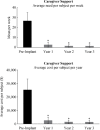Economic Consequences of an Implanted Neuroprosthesis in Subjects with Spinal Cord Injury for Restoration of an Effective Cough
- PMID: 29339903
- PMCID: PMC5562035
- DOI: 10.1310/sci2303-271
Economic Consequences of an Implanted Neuroprosthesis in Subjects with Spinal Cord Injury for Restoration of an Effective Cough
Abstract
Objective: To determine if an implanted neuroprosthesis for restoration of an effective cough is less costly than conventional methods of respiratory management. Methods: Nonrandomized clinical trial of participants (N = 14) with spinal cord injury (SCI) using the Cough Stimulator device in the inpatient hospital setting for Cough Stimulator implantation and outpatient hospital or residence for follow-up. A neuroprosthesis was implanted for restoration of an effective cough. The annual costs associated with respiratory management, without (pre implantation) and with (post implantation) the neuroprosthesis, were examined over a 4-year period. Results: The total cost related to implantation of the Cough Stimulator was $59,891, with no maintenance costs over subsequent years. The incidence of respiratory tract infections and the need for caregiver support fell significantly following implantation. The costs associated with respiratory tract infections fell significantly from a mean of $36,406 ± 11,855/year to $13,284 ± 7,035/year (p < .05) pre and post implantation, respectively. Costs fell further to $8,817 ± 5,990 and $4,467 ± 4,404 following the 2nd and 3rd years post implantation (p < .05), respectively. The costs associated with caregiver support fell significantly from $25,312 ± 8,019/year to $2,630 ± 2,233/year (p < .05) pre and post implantation, respectively, and remained low in subsequent years (p < .05). Other costs related to secretion management fell significantly and remained low in subsequent years (p < .05). Break-even analysis demonstrated that this point was reached in the first year. Conclusion: The results of this investigation demonstrate that implantation and use of the Cough Stimulator resulted in significant reductions in the overall costs of respiratory management in this patient population.
Keywords: cough; economics; expiratory muscles; rehabilitation; spinal cord stimulation.
Figures



References
-
- National Spinal Cord Injury Statistical Center , Facts and Figures at a Glance. Birmingham, AL: University of Alabama at Birmingham, 2015. https://www.nscisc.uab.edu/PublicDocuments/fact_figures_docs/Facts%20201.... Accessed August 18, 2016.
-
- Marsolais EB, Boninger ML, McCormick PC, . et al. Respiratory management following spinal cord injury: A clinical practice guideline for health-care professionals. J Spinal Cord Med. 2005; 28 3: 259– 293. - PubMed
-
- Meyers AR, Feltin M, Master RJ, . et al. Rehospitalization and spinal cord injury: Cross-sectional survey of adults living independently. Arch Phys Med Rehabil. 1985; 66 10: 704– 708. - PubMed
-
- Cardenas DD, Hoffman JM, Kirshblum S, McKinley W.. Etiology and incidence of rehospitalization after traumatic spinal cord injury: A multicenter analysis. Arch Phys Med Rehabil. 2004; 85 11: 1757– 1763. - PubMed
-
- Samsa GP, Landsman PB, Hamilton B.. Inpatient hospital utilization among veterans with traumatic spinal cord injury. Arch Phys Med Rehabil. 1996; 77 10: 1037– 1043. - PubMed
MeSH terms
Grants and funding
LinkOut - more resources
Full Text Sources
Other Literature Sources
Medical
